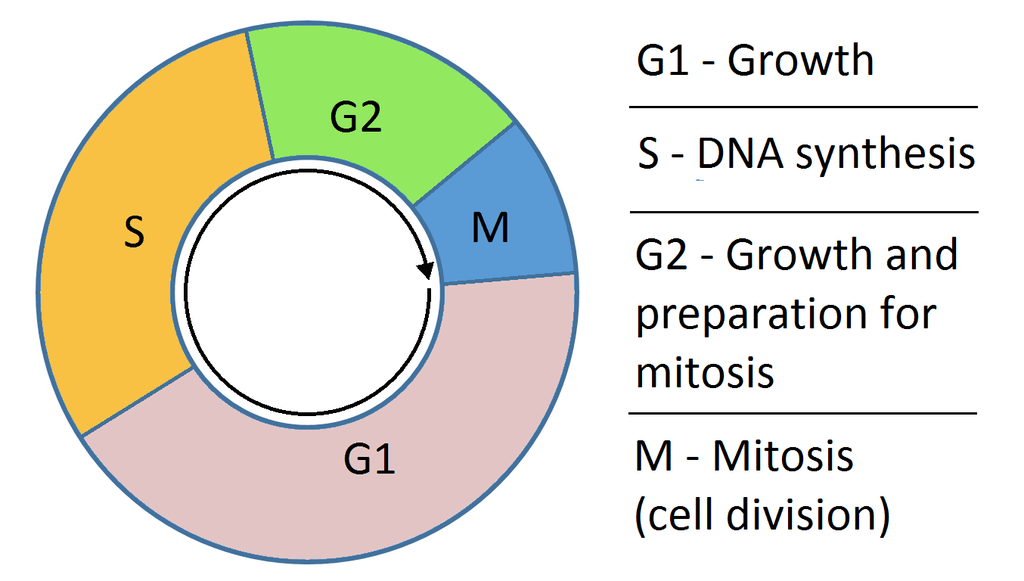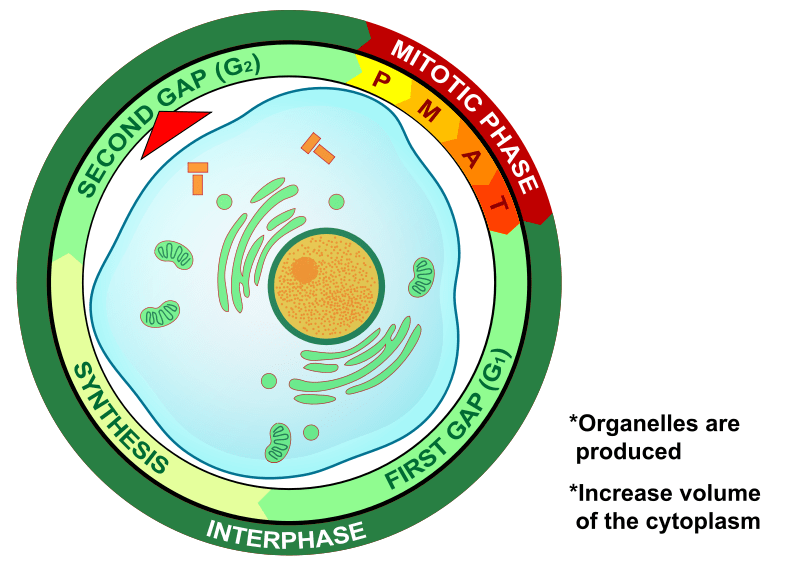Difference Between G1 and G2 Phase of Cell Cycle
Key Difference – G1 vs G2 Phase of Cell Cycle
Cell division is considered as an important aspect of reproduction, growth, and development of an organism. Two types of cell divisions are seen in organisms namely, mitosis and meiosis. The cell cycle is composed of main two phases such as interphase and mitotic phase. Interphase is the longest phase in which cells prepare for division by growing the cell and making a copy of its DNA. Interphase is divided into three substages; G1 phase, S phase, and G2 phase. The duration of these sub-phases depends on the type of organism. G1 phase is the first substage of interphase which has a longer process while the G2 phase is the last substage of interphase and is considered to be relatively a short phase. During the G1 phase, the cell shows first growth by copying organelles and making the molecular building blocks which are necessary for later steps. During the G2 phase, the cell shows the second growth by making proteins and organelles and beginning to reorganize its contents in preparation for mitosis. This is the key difference between G1 and G2 phase of a cell cycle.
CONTENTS
1. Overview and Key Difference
2. What is G1 Phase of Cell Cycle
3. What is G2 Phase of Cell Cycle
4. Similarities Between G1 and G2 Phase of Cell Cycle
5. Side by Side Comparison – G1 vs G2 Phase of Cell Cycle in Tabular Form
6. Summary
What is G1 Phase?
G1 phase is the first cell growth phase of the interphase of the cell cycle. This is also referred to as Gap 1 stage. G1 phase is the first substage of interphase. Significant development processes occur within the cell at G1 phase. The cell will increase its size due to the extensive synthesis of proteins and RNA that causes the cell growth. It also helps during the replication of DNA. Proteins that synthesize during G1 phase include mainly histone proteins. The majority of RNA synthesized is mRNA. Histone proteins and mRNA involves during DNA replication.
The duration of the cell cycles varies according to the type of organisms. Some organisms will have a longer G1 phase before entering the S phase, and other organisms may have a shorter G1 phase. In humans, a typical cell cycle will take place for 18 hours. Out of the total time for the complete cell cycle process, the G1 phase will take 1/3 of that period. But this time may change due to certain factors. These factors are referred to as growth factors which include cellular environment, availability of nutrients such as proteins and specific amino acids and cellular temperature. The temperature mainly affects the proper growth of organisms, and this value varies from organism to organism. In humans, the optimum temperature for cellular growth is roughly 37 0C.

Figure 01: G1 and G2 Phases
The cell cycle regulatory mechanism controls the regulation of G1 phase which includes the duration and coordination between other phases. G1 phase is considered to be an important phase since its a point where it determines the fate of a cell that includes either to proceed with the rest of the cell cycle phases or leave the cell cycle. If a signal is induced to keep the cell at an un-dividing stage, the cell will not enter into the S phase. The cell will move into a dormant phase known as G0 phase without continuing the cell division.
What is G2 Phase?
During the interphase of the cell cycle, once the G1 phase and S phase is completed, the cell will enter into the G2 phase. It is also known as the Gap 2 phase. G2 phase is the final substage of interphase. When compared with G1 phase, the G2 phase is a shorter phase. It is considered to be an important phase in the cell cycle in the context of growth and protein synthesis since extensive cellular growth take place under high synthesis rate of proteins. With the synthesis of necessary RNA and proteins, it also helps the formation of spindle apparatus during mitosis. Even though this phase is considered as important, this stage could be avoided by a cell and thus, can directly enter into the mitosis phase once S phase is completed. But by completing G2 phase, cell become fully prepared for mitosis.

Figure 02: G2 Phase
If a cell enters the G2 phase, it confirms the fact that the cell has completed the S phase where DNA replication has taken place. Therefore, all cells in G2 phase will progress to mitosis where the cell will be divided into two identical daughter cells. In G2 phase, the cell size increases along with different components such as the nucleus and almost all the other cellular organelles. Similar to G1 phase, the G2 phase is also regulated by cell cycle regulatory mechanisms. Once the G2 phase completes, it completes the interphase of the mitotic cell division.
What are the Similarities Between G1 and G2 Phase of Cell Cycle?
- Both are important phases of cell cycle.
- Both phases are involved in the cell growth before its division.
- Cell cycle regulatory mechanisms will control both phases,
What is the Difference Between G1 and G2 Phase of Cell Cycle?
G1 Phase vs G2 Phase of Cell Cycle | |
| G1 phase is the first phase of the interphase of the cell cycle in which cell shows a growth by synthesizing proteins and other molecules. | G2 phase is the third phase of interphase of the cell cycle in which cell prepares for nuclear division by making necessary proteins and other components. |
| Sub Stage of Inter Phase | |
| The first substage of interphase is a G1 phase. | The last substage of interphase is a G2 phase. |
| Synthesis of RNA and Proteins | |
| Occur in G1 phase for cell growth and DNA replication | Occur in G2 phase which is essential for spindle formation and mitosis. |
| Progression | |
| G1 phase proceeds into S phase where DNA replication occurs. | G2 phase proceeds into the mitotic stage. |
Summary – G1 vs G2 Phase of Cell Cycle
G1 phase and G2 phase are two phases in the interphase of the cell cycle. The duration of the cell cycles varies according to the type of organisms. G1 phase is the first substage of interphase. G2 phase is the final substage of interphase. Significant development processes occur within the cell at G1 phase. When compared with G1 phase G2 phase is a shorter phase. Proteins that synthesize during G1 phase include mainly histone proteins and the majority of RNA synthesized is mRNA. If a cell enters the G2 phase, it confirms the fact that the cell has completed the S phase where DNA replication has taken place. Cell cycle regulatory mechanisms will control both phases. This is the difference between G1 phase and G2 phase of the cell cycle.
Download the PDF Version of G1 vs G2 Phase of Cell Cycle
You can download PDF version of this article and use it for offline purposes as per citation note. Please download PDF version here Difference Between G1 and G2 Phase of Cell Cycle
Reference:
1.Alberts, Bruce. “An Overview of the Cell Cycle.” Molecular Biology of the Cell. 4th edition., U.S. National Library of Medicine, 1 Jan. 1970. Available here
2.Cooper, Geoffrey M. “The Eukaryotic Cell Cycle.” The Cell: A Molecular Approach. 2nd edition., U.S. National Library of Medicine, 1 Jan. 1970. Available here
Image Courtesy:
1.’Cell cycle simple’ By Simon Caulton – Own work, (CC BY-SA 3.0) via Commons Wikimedia
2.’Second gap cell lifecycle’ By LadyofHats (Public Domain) via Commons Wikimedia
ncG1vNJzZmivp6x7pbXFn5yrnZ6YsqOx07CcnqZemLyue8OinZ%2Bdopq7pLGMm5ytr5Wau26zkGaYp5xdq8Bus5Fmp6GZo5p6sLKMnJylpF2YxqS4xGg%3D